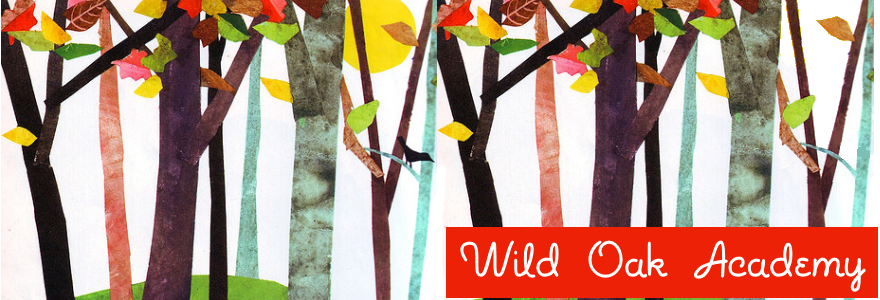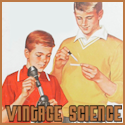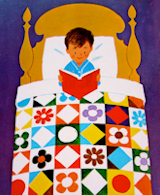 As previously mentioned, today we ordered silkworms for our study of Ancient China. From Carolina Biological Supply, we will receive 25 silkworm eggs, a silkworm farm kit and silkworm artificial dry diet. I didn't realize that we would have access to fresh mulberry leaves, but that won't be until spring, so I guess the food was a good idea!
As previously mentioned, today we ordered silkworms for our study of Ancient China. From Carolina Biological Supply, we will receive 25 silkworm eggs, a silkworm farm kit and silkworm artificial dry diet. I didn't realize that we would have access to fresh mulberry leaves, but that won't be until spring, so I guess the food was a good idea!
I'm almost embarrassed to admit what I did next...after some additional searching online, I discovered Coastal Silkworms, an inexpensive source for live silkworms and other supplies (and according to the reviews, they're of excellent quality). So yes, I ordered from them as well (and am feeling rather ill about the money spent). Now we'll have live silkworms and eggs coming next week...quite a lot of silkworms in all!
For anyone interested, the following sites have some good information on raising silkworms:
- The Silkworm: A very thorough (.PDF) guide to raising silkworms
- Serving the Tiny Masters: "Adventures in home sericulture," from Wormspit
- Wormspit: All about silkworms, silkmoths and silk
- Silkworms: This site is especially for teachers and has a lot of helpful information
- Silkworm Raising FAQ: From Aurora Silk
- My Silkworm Story: A 3rd grader's adventures in raising silkworms
- Silkworms: Another sericulture journal, from Mother at Home

Labels: Science
This week was quieter than usual, but a good one nonetheless! In History we finished reading "Mara, Daughter of the Nile" and learned about mummies and how the pyramids were built. We explored this further with a couple of kits, and tried our hand at drawing pyramids (using "Draw and Write Through History"). Elon discovered that by applying some pressure with the beeswax crayons, he can then rub/blend the colors to a perfectly smooth and flawless finish -- he did this for his desert sand, below.

Thinking ahead, I've been working on compiling a new curricula schedule for the remainder of the year - combining elements from both Sonlight and Winter Promise, as well as other resources. So far, the results look very promising, so I'm quite excited! It combines just the right amount of reading, mapwork, notebooking and hands-on activities, etc., in addition to our Bible and Science studies. It also includes the appropriate copywork and memory work, art and music! Most importantly, everything is lining up exactly - so we won't be reading about the Israelites while studying Greece, for example (both Sonlight and Winter Promise have some overlap that bugs me, so I was thrilled to eliminate it).
My reason for re-writing the schedule was that I wanted to take a less confusing regional approach to each ancient culture, rather than jumping around to cover everything chronologically. Also, I wanted everything to be completely planned out and coordinated, so that we can immerse ourselves fully in each culture as its studied.
In other History news (or perhaps Science?), we ordered Silk Worm eggs today, to be delivered on March 5th. I'm hoping they'll be ready to spin silk as we start on our study of Ancient China. My elementary science teacher always kept silk worms in her classroom and I have such fond memories of them that I thought the kids would enjoy them as well. Sadly, that's the only bit of Science news I have. I know, I'm such a slacker, but I just can't seem to motivate myself to start our Rocks & Minerals unit (despite the fact that it's a favorite of mine!). The kids also reminded me that we have yet to erupt our volcano, so I'm hoping we can work on that this weekend. Yikes.
Language Arts has been a slight mess this week...we're still stuck on diagramming in Rod & Staff (which, again, reminds me that we probably need to take a "time out" and work on the parts of speech!). It doesn't help that their public school friends are scornful of diagramming, since it's apparently not taught anymore. We did manage to get through two CLE Reading lessons and have been thoroughly enjoying our first week of "Excavating English." Thus far, I haven't had to modify it in the least - even my 8-year-old is enthusiastic about it because it's really quite interesting! It has led to some wonderful discussions as well. For our AWAD vocabulary, we've learned contumacious, lachrymose, peripatetic, obstreperous and coeval. Their retention has been great, though it's rather amusing to hear them actually using such large words (lachrymose and obstreperous were the favorites)!
For Music this week we have been listening to Music of the Ancient Sumerians, Egyptians and Greeks by Ensemble De Organographia. The liner notes are quite excellent and explain the origination of each song, along with the instruments used. For example, one of our favorites, "Theban Banquet Scene" comes from a 14th century BC tomb painting found in Thebes (the song can be heard here): "The painting depicts a scene of four rows of guests preparing to attend a banquet with guests on the left of each row displaying chironomy signs and instrumentalists on the right. The signs, indicated by the various inclinations of the guests' arms, apparently documents the rise and fall of the melody being played by the musicians." Quite fascinating! The instruments used on the CD are either original or faithful reproductions of ancient instruments; a photograph of all the instruments is also shown.
The rest of our work this week has been unremarkable; everything is mostly going smoothly and according to schedule. Let's hope it continues!
Labels: Weekly Report
Restoration Place has many lovely ideas for a Nature Table:
 As does Maya*Made:
As does Maya*Made: From good + happy day:
From good + happy day: Waldorf-inspired nature tables by KnechtRuprechtDolls at Flickr:
Waldorf-inspired nature tables by KnechtRuprechtDolls at Flickr:
 And another, from SlowCat at Flickr:
And another, from SlowCat at Flickr:
Labels: Nature Table
I don't know why, but Mondays always seem to drag. Today I tried to liven things up by including a couple of hands-on projects. Lift the Lid on Mummies:
Lift the Lid on Mummies:
 Dancing to a "Theban Banquet Scene," from Music of the Ancient Sumerians, Egyptians and Greeks by Ensemble De Organographia:
Dancing to a "Theban Banquet Scene," from Music of the Ancient Sumerians, Egyptians and Greeks by Ensemble De Organographia: The completed mummy:
The completed mummy: Mystic Egyptian Tomb Dig & Play (I strongly suggest doing this outside!):
Mystic Egyptian Tomb Dig & Play (I strongly suggest doing this outside!):
 Some of the "artifacts" found, game board and game pieces:
Some of the "artifacts" found, game board and game pieces:
Labels: Ancient Egypt
This afternoon we found more wonderful fairy houses, this time from Etsy artist Centaur1201 (she's also got a website, Rachel's Fairy Houses):

 This gnome house from Gnome Sweet Home is also quite charming:
This gnome house from Gnome Sweet Home is also quite charming: We found a Build a Fairy House Kit and more fairy furniture, from Sunflowerhouse:
We found a Build a Fairy House Kit and more fairy furniture, from Sunflowerhouse:
 This Enchanted Fairy Cabinet, by Spirited Woodland is amazing:
This Enchanted Fairy Cabinet, by Spirited Woodland is amazing:
Labels: Fairies
Recently Maddie and I decided that we needed a fairy house, so we began to do some research. Many years ago I came quite close to ordering from the now defunct Toad Hollow Farms, makers of these fabulous Tree Stump Homes:
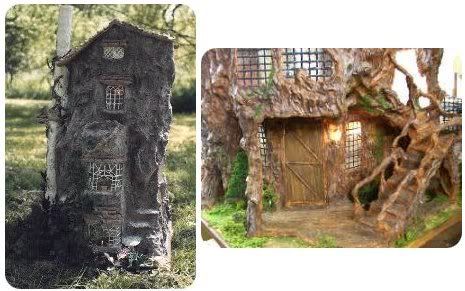
Oh how I wish I had (note the stained glass windows)! Their site can still be viewed here, thanks to the magic of the Internet Archive, and they remain a great source of inspiration to us. We also discovered artist John Curtis Crawford's Fairy Woodland ("Fine Handcrafted Homes for Discriminating Fairy Folk"). In particular, Maddie was drawn to this house, though she thought it a little austere:
 Most importantly, she'd like something delicate enough to please the fairies, yet sturdy enough to play with. We discovered that there's a Fairy House book series, by author Tracy Kane, as well as a Fairy Houses Weekend in Portsmouth, NH (check out the photos in this Fairyland Set on Flickr). There is even a Squidoo lens on Fairy Houses. Here, we found instructions on how to build our own fairy house:
Most importantly, she'd like something delicate enough to please the fairies, yet sturdy enough to play with. We discovered that there's a Fairy House book series, by author Tracy Kane, as well as a Fairy Houses Weekend in Portsmouth, NH (check out the photos in this Fairyland Set on Flickr). There is even a Squidoo lens on Fairy Houses. Here, we found instructions on how to build our own fairy house:- How to Build a Fairy House: From Tracy Kane's website
- Fairy Houses: From Disney's Family Fun website
- How to Transform Your Dollhouse Into a Faerie House: From wikiHow


 Then, of course, there's the matter of furnishing our fairy house. Maddie loved this furniture from Forest Whimsy:
Then, of course, there's the matter of furnishing our fairy house. Maddie loved this furniture from Forest Whimsy: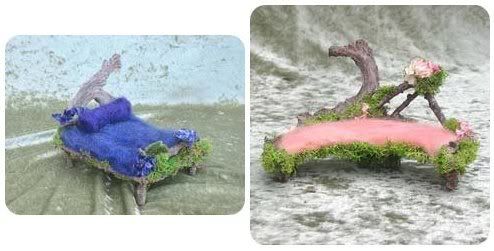
We were also greatly inspired by the designs at this Japanese nut craft site (perfect for a fairy kitchen!):
 And we're in love with these fairy rooms, from Twig Wizardry (click on the photos to enlarge):
And we're in love with these fairy rooms, from Twig Wizardry (click on the photos to enlarge):


 So, now begins the work of collecting materials and determining how best to build our house. Maddie thinks perhaps we ought to buy a house and then create our own, since it will likely take awhile to collect the needed materials (and she does have a birthday coming up). She envisions an entire fairy village one day. We also have a dollhouse cottage, waiting to be assembled, so we may opt to re-work that into something magical, but we're carefully weighing our options.
So, now begins the work of collecting materials and determining how best to build our house. Maddie thinks perhaps we ought to buy a house and then create our own, since it will likely take awhile to collect the needed materials (and she does have a birthday coming up). She envisions an entire fairy village one day. We also have a dollhouse cottage, waiting to be assembled, so we may opt to re-work that into something magical, but we're carefully weighing our options.As for the fairy folk themselves, she's anxious to create them, too. She enjoys making these flower fairies from Felt Wee Folk, which ought to be just right:

All in all, it ought to be the perfect Spring project!
Labels: Fairies
A Beginner's Guide to Constructing the Universe
1 comments Posted by Kristine at 2/22/2009 09:19:00 AM Very seldom do I get so excited about a book that I just have to talk about it, but this would be an exception. What's even more unusual is that this is a book about math, and math has always been the bane of my existence! In fact, my husband laughed when he heard I'd purchased it, unable to imagine that I would voluntarily read such a thing. The book is called A Beginner's Guide to Constructing the Universe: The Mathematical Archetypes of Nature, Art and Science and is easily one of the most fascinating things I've ever read. Though I've only started on the book recently, I felt it was too good not to share. It delves into sacred geometry, the mathematics underlying creation, and explores the way math is expressed in everyday life through every aspect of the universe. Personally, I was hooked after this introduction to Chapter 1:
Very seldom do I get so excited about a book that I just have to talk about it, but this would be an exception. What's even more unusual is that this is a book about math, and math has always been the bane of my existence! In fact, my husband laughed when he heard I'd purchased it, unable to imagine that I would voluntarily read such a thing. The book is called A Beginner's Guide to Constructing the Universe: The Mathematical Archetypes of Nature, Art and Science and is easily one of the most fascinating things I've ever read. Though I've only started on the book recently, I felt it was too good not to share. It delves into sacred geometry, the mathematics underlying creation, and explores the way math is expressed in everyday life through every aspect of the universe. Personally, I was hooked after this introduction to Chapter 1:
"In the fourteenth century Pope Benedictus XII was selecting artists to work for the Vatican, requesting from each applicant a sample of his ability. Although the Florentine painter Giotto (1266-1337) was known as a master of design and composition, he submitted only a circle drawn freehand, the famous 'O of Giotto.' Yet he was awarded the commission. Why? What's so impressive about a simple circle?"
From the back cover, "Michael Schneider leads us on a spectacular, lavishly illustrated journey along the numbers one through ten to explore the mathematical principles made visible in flowers, shells, crystals, plants and the human body, expressed in the symbolic language of folk sayings and fairy tales, myth and religion, art and architecture. This is a new view of mathematics, not the one we learned at school but a comprehensive guide to the patterns that recur through the universe and underlie human affairs."
Sprinkled with quotes and over 500 wonderful illustrations, the book includes insight into ancient approaches to math (and subsequently the universe, art and architecture), as well as a sort of history of each number through the ages. Additionally, there are hands-on exercises to complete, constructing the various geometric shapes highlighted in each chapter, using only a compass and straight-edge. I should mention that this book is written for the layman, so offers easy reading, even for the math illiterate such as myself! According to the author, "This book wasn't written for mathematicians, but for those of us who were turned off by mathematics as it was taught in school." An informative Voice of America interview with the author can be found here.
The author's website offers additional material to explore, including a series of activity books with "670 pages of original hands-on activities, completely illustrated, guiding you to create and explore the geometric patterns found in nature and art." It promises to be "Ideal for Teachers, Artists, Designers, Architects, Home Schools, and Self-Motivated Learners!" I'm thinking this would be a very interesting way to introduce my eldest to geometry, so will be ordering the activity books for further exploration. Incidentally, the book would also work very well with Joy Hakim's The Story of Science: Aristotle Leads the Way.
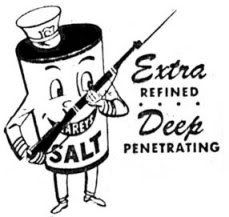
A 1950's postcard of the mine:

This salt deposit is one of the largest deposits known in the world, 4,000 square miles in area, covering parts of Kansas, Oklahoma, and Texas. The museum is the only of its kind in the United States. With more than 67 miles of mined caverns, the salt mine produces 500,000 tons of rock salt each year, with approximately 80% used for road deicing and 20% used for cattle supplements. Rock salt is 95% halite and contains shale and other impurities. Today, the mine employs only 5 miners per shift, with an additional 5 employees serving as drillers, mechanics, explosive experts, etc.
Cool formations on the mine's walls:

An additional 65-70 employees work for Underground Vaults and Storage. The mine is perfect for storing a variety of artifacts because it is secure and offers a stable year-round temperature of 68° F and constant 42% humidity. All but one of the major Hollywood studios stores their film reels here.
Nearby, the Cargill and Morton plants produce common table salt - mined from the very same salt deposits, as well as salt for many other purposes. Amazingly, there are over 14,000 uses for salt!
Here's a slideshow from our visit:
Labels: Field Trips
This week was quite busy, though a tad disjointed because we did so many different things! I won't even try to summarize everything here because that would be tedious, but here's a bit of what we did...
For History, we had to juggle some things around in order to be at the correct starting point for next week's lessons. That mostly entailed reading a lot from "Mara, Daughter of the Nile" since we needed to have thirteen chapters completed. The kids aren't enjoying this book quite as much as the last, though I'm enjoying it immensely! I'm hoping that next week we'll be able to follow the Sonlight IG as scheduled, that would be such a relief.
We had a bit of a disaster with our timeline books. Due to everyone's overly generous use of glue, several of the pages in each book became stuck together. Naturally, this resulted in ripping when we tried to separate them. Major bummer. Now I know why Sonlight uses timeline stickers, however, I seem to have misplaced the stickers we received from them and can't find them anywhere!
Language Arts: We did more work on sentence diagramming in R&S English, learned about paragraphs and started on our new CLE Reading Units (so far, so good - they're enjoying them). We also had our first dictation exercise - a passage from "Mara." For some reason, dication stressed the boys out to a ridiculous degree, while Maddie breezed right through it. The entire exercise took nearly 40 minutes (for one short paragraph!), so I think we'll be sticking to to copywork a bit longer.
Thanks to Maria at Eclectically Yours, I discovered a fantastic book that I've decided to use this semester, before starting on a roots program for vocabulary. The book is called Excavating English and is described as a "hands-on dig into the multicultural roots of English from 4000 BC to the present." Though it is intended for grades 6 to 10, I believe it can be adapted easily enough for my younger students, based on the sample chapters I've reviewed. It will go quite well with our history his year so I can't wait until it arrives!
Incidentally, the author of the book also has a chemistry book entitled, The Elements: Ingredients of the Universe. The curriculum, designed for grades 4-8, uses cooking and many other hands-on activities to introduce children to the Periodic Table. There's even an elements fairy tale, "The Periodic Kingdom." A review of the curriculum can be found at Rainbow Resources. Now I'm not sure when or how I could work this into our schedule, but I really, really want to and I don't even like chemistry!
Yikes, but back to our weekly report...the kids continued to work at their own pace in Math, doing at least one lesson per day from the Singapore textbook and workbook. For the most part, they're not finding it too difficult, which is nice.
We also began reading "Philosophy for Kids" and it was a great success...they really enjoyed debating what was just and fair! In addition, they started on "Grid Perplexors" Book A (for the 4th graders) and Book B (for Dominic/6th grade). Initially they were quite resistant, but after the first puzzle they were hooked and begging for more.
In Science we started our Geology unit by learning about plate tectonics, earthquakes and volcanoes. A friend brought us an enormous rock with salt crystals, which prompted us to schedule a field trip tomorrow at The Underground Salt Museum.
 I had hoped to begin studying rocks and minerals before the field trip, but that didn't exactly happen. However, we did spend some time looking at our fluorescent mineral kit again and examining the tub of rocks and minerals we'll learn how to test and identify next week. The boys also read from our DK Rocks & Minerals book, among others, looking for information on salt. Finally, we found some good information on How Stuff Works.
I had hoped to begin studying rocks and minerals before the field trip, but that didn't exactly happen. However, we did spend some time looking at our fluorescent mineral kit again and examining the tub of rocks and minerals we'll learn how to test and identify next week. The boys also read from our DK Rocks & Minerals book, among others, looking for information on salt. Finally, we found some good information on How Stuff Works. Aragonite, Hackmanite and Scapolite:
Aragonite, Hackmanite and Scapolite: Lastly, the boys had fun with this Amusement Park Physics site, testing some of what they'd learned with our Quadrilla Marble Run and some wavy wooden blocks.
Lastly, the boys had fun with this Amusement Park Physics site, testing some of what they'd learned with our Quadrilla Marble Run and some wavy wooden blocks.All in all, it was another good week. Nearly all of my recent curricula additions have arrived, so I'm looking forward to a more complete schedule next week.
Labels: Weekly Report
Today the kids worked on their doodles for Google all afternoon; this year's theme is "what I wish for the world." Maddie, ever the prolific artist, effortlessly turned out one doodle after another, though she disregarded the theme entirely. Dominic agonized over everything, but in the end came up with a fantastic drawing that he wouldn't let me photograph. Elon decided to do his on the computer and Jaymon experimented with a number of ideas, finishing nothing.

 Maddie's sea creatures:
Maddie's sea creatures: Maddie's, "What if everyone in the world could sleep more?" (LOL)
Maddie's, "What if everyone in the world could sleep more?" (LOL) Some of the rejected sketches, by Maddie (top) and Jaymon (bottom):
Some of the rejected sketches, by Maddie (top) and Jaymon (bottom):
